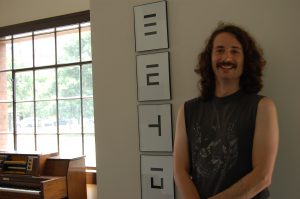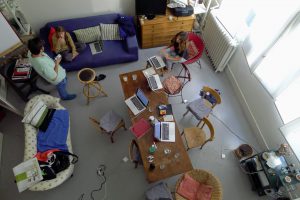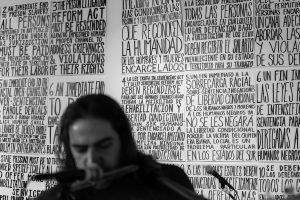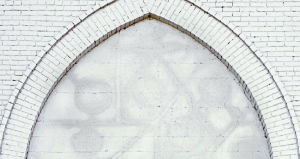MEET ABRAHAM RITCHIE, CONTEMPORARY ART CRITIC IN CHICAGO
A few weeks ago Abraham Ritchie set an hour aside during his lunch break at the Art Institute (in the Manet room) to sit and talk about his career as a contemporary art critic in Chicago. Abraham elaborated on how he established his career as an art critic and what his role as a contemporary art critic should be. Moreover, he provided an incredibly coherent, sincere and well-informed perspective about the condition of art in Chicago and some solutions that may help remedy some of the shortcomings that art has had in Chicago over the last few years. Abraham Ritchie is unapologetic and speaks eloquently about his critical opinions. Perhaps this is the reason why his writing is well received. Below is the shortened version of a larger transcript from the interview. Because of the depth and breadth of the interview each segment is categorized with a broad heading instead of the original questions.

INTRODUCTION
My name is Abraham Ritchie I am the senior editor for ArtSlant Chicago I am a freelance art critic so I write for New City and I am also the administrator/creator of the Chicago Art blog that is on WordPress but now on the Chicago Now family of blogs. Those are the three main places where my writing appears. It has appeared elsewhere I have written on art for Madison Newspapers incorporated previously but those are the three main places in Chicago where you can find my writing, mainly on ArtSlant.
WHY CHICAGO?
What motivated my move to Chicago wasn’t really an employment offer or anything like that. Of course, coming to Chicago from Madison if you want to do art criticism unfortunately for an emerging critic that is building their body of work and crafting their voice and their critical platform you have to move to three cities, essentially Chicago, LA or New York. Those are the only cities that have the wide community and a lot of opportunity for writing. So I decided to move here because of the larger community and a wider audience that I was hoping to connect with and I eventually did.
CAREER PROGRESSION
It is just persistence and keeping on being involved. It was pretty quick, which I feel pretty lucky about. In that sense also it was more a result of being committed to writing years ago when I was in Madison and doing writing there and doing blogs there for no pay and making connections to news papers and finally getting paid a little bit for my articles and then coming here and doing the same thing. So it was pretty quick but it was really a result from the years prior that I had been writing and building that body of work.
I have always been very committed to creating an art dialogue and engaging in that dialogue with artists, other critics and other people that are interested in art. I didn’t have anything lined up when I came here so I just started writing. The most important thing to me is producing the content and creating the dialogue. Even if you are not writing an essay that is the equivalent of The Avant Garde and Kitsch it is important to stay involved and keep writing. So I just started a blog and started writing on that initially, that was the Chicago art blog on WordPress and I also kept making connections to other people.
WRITING FOR AN AUDIENCE
Not everybody will want to read everything that I write but I want to talk to everybody about the things that they are interested in. So that has been interesting getting to know the audience in different places. But I think the media now is worrying about if they are appealing to a particular audience and they are not focusing so much on the content and the character of the writing and I am more focused about that because people are drawn to the writing and not drawn to a publication or something like that. I think that content will always be more important than trying to cater to a public’s perceived interest. You have to stay true to what you want to write and how you want to write it.

CONNECTING WITH ARTISTS
I definitely don’t have a close relationship with any artist. And to use your example, Clement Greenberg ultimately ended up really trying to determine a lot of Jackson Pollock’s work and then later he would go on and try to do artist’s work for them and that is not really what I want to do. Obviously Greenberg’s champion of Abstract Expressionism is a monumental achievement but if you look at the story after the 1950s it becomes an issue of meddling. He was the executor of Tony Smith’s estate and there was the story of him stripping off paint from sculptures. I definitely do not have that but that is not to say that I am not friendly with artists or sympathetic to artists work. I guess I perceive a bit of a danger of becoming to comfortable with an artist in that sense and losing or becoming compromised by your friendship because it would be hard to critique a good friend and their art.
PICK OF THE CROP
What does drive a lot of it is looking for the best work out there. At ArtSlant we do pure criticism so there are no sponsored posts. So this is all very unattached criticism and we are totally free to pursue whatever we want. Aesthetic terms and current events can dictate what we want to cover. Obviously with this whole Smithsonian censorship thing, that is a big interesting travesty really, of freedom of speech, museum display in general and leadership. There are different things that guide us from week to week and day to day and that is sort of my role, to determine the things that we want to talk about. That is a responsibility that I take very seriously because that is determining the larger discourse of art.
CHICAGO’S STRENGTHS AND CREATING OPEN DIALOGUE
I think that one of the strengths about Chicago is the level of access here. It is a smaller art community compared to LA or New York City and it is also more closely knit. All the active critics know each other and we know all of the strong emerging artists. I don’t have a grand plan for being here and my position here. I think that my experience all along has sort of been to keep on writing and investing my time writing where more opportunities will open up for art criticism and writing. I am just hoping that what I do is part of building a larger scene so that more people feel like they can get their voice out there and participate in that dialogue. That is really what I would like to see happen is being a part of creating a larger dialogue that would involve more people and get more people interested in talking about art or going to see contemporary art or talking about things that they dislike about contemporary art even because I think that those are all productive things. I think my skills set is very broadly useful and if it becomes sort of a teaching thing that is fine too.

RESPONSIBILITY AS A WHOLE (Community, Culture & Politics)
There are a lot of people out doing different things. But I am weary, in my particular position, of assigning people to do certain things. In that sense I am kind of seeing the question more related to criticism and art writing and binding these disparate projects together as sort of a narrative and something that makes sense. So I think that is a project for criticism. The question maybe points to a larger problem as a whole. Because I mean, we all want art to be affordable but all the artists also want to make a living at what they are doing. I feel that as a writer I want everybody to have access to my writing but I also like to get paid for the work that I am doing. I think that is at its heart an economic issue. Because like you said, the thing with the galleries closing they are not surviving these economic times and other galleries do not really want to support emerging or smaller galleries because that is their competition. I guess on those terms smaller galleries have to look at how they are approaching the market and what they want their market share to be.
But I mean that maybe is beside the point. I think that this is more of an issue of politics and removing the red tape and bureaucracy that is around creating these live-work spaces. I mean they are talking about the spice barrel district as far as an artist area. That makes sense to me because we have all these abandoned buildings in Chicago and we should use them. But I think ultimately the power is with the people rather than with the politicians because once people start making these connections then that is the way things get done. I think Chicago is really great in those terms too because if you look at Co-Prosperity Sphere or even The Chicago Urban Art Society I mean they do collaborative projects all the time. I think there are a lot of missed connections too but is a result of people being interested in different things because if would be horribly boring if we were having the same conversation all of the time. I think that there are two sides to that coin in many respects.

BUILDING A NEW IDENTITY IN CHICAGO
How we create a new identity for Chicago is through culture and the building of the arts. I think you can build Chicago as a business capital but as far as an identity we need a new identity in the city. We are only going to have the Stanley Cup in Chicago for so long and we all like sports but I don’t think that that is going to be enough. I think that culture can be a point where we can come together as a city while also retaining our own personal distinctiveness and culture. I love the fact that down my street on Irving Park that there is The Bulgarian Cultural Center and The Ukrainian Museum of Modern Art here. I think that that is really what we need to emphasize and move forward in the way the politics can embrace culture and sponsor it with out compromising production too. I think that we have seen the beginnings of that in Millennium Park and we need to keep on doing that. We need to recognize that arts and culture contributes to our economy just in the way that any other industry does.

PARTICIPATION AND COOPERATION
For right now, I think that there is an extraordinary amount of talent in Chicago and we keep on attracting just because we draw from all over the Midwest. As far as what Chicago could use in those terms is I would like to see more organizations step up to the plate and start to nurture and show that. There have been so many gallery closings over the last two years and we have lost a lot of really great artists. If there are no opportunities for people to exhibit here or collectors buying and supporting emerging artists then they just move to New York. Like Wafaa Bilal, he was doing work here for years and then Flat File closed and shortly thereafter he moved to New York and now he is getting a lot of press out there for the work that he is doing. So he is just one example of an artist that left the city. So I would like to see Chicago start retaining artists. I recently read an interview (I think it was in Art in America) about how LA started becoming an arts capitol in and of itself and the person who was responding said that once artists stopped leaving LA to move to New York and start staying, that is when they started building and now they have a well known repertoire of names. I think that is what we need to do in Chicago. We need to start retaining our artists through different ways. That will be the big beginning because what I do is just one piece of the pie and there needs to be a lot of cooperation across a broad scale for the scene to really grow.
For more information and art reviews by Abraham Ritchie take a look at the 5 plus pages of archives on ArtSlant as well as The Chicago Art Blog at Chicago Now and New City. Keep posted for future follow up interviews. To request a full transcript and or audio contact Nicolette.caldwell@gmail.com.



